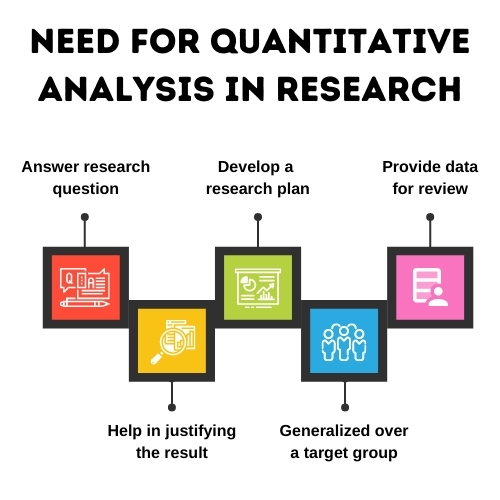In Brief:
- It is the best way to study a particular group of people, also known as the sample population. Quantitative research depends on data that are detected to inspect questions about the sample population.
- Quantitative research method provides an answer to the research questions.
- When the data is collected and analysed by a standardised, reputable methodology, it always produces trustworthy results.
Introduction
Quantitative Data analysis is a leading research framework used in social sciences. It comprises a set of strategies, methods, and assumptions that are helpful in psychological, social and economic study processes by examining numerical patterns. It collects a large number of numerical data. Some of the numeric, quantitative data are intrinsically quantitative, e.g. personal income, but in other cases, the numerical structure is imposed, e.g. On a scale of 1 to 10, “how miserable you were last week?” The gathered quantitative information allows the researcher to have simple to extremely sophisticated statistical analysis that aggregate data, i.e. average, percentage, help find the relationship among the data or compare aggregated data. Some of the major quantitative methods are questionnaires, structured observations or experiments, and contrast to qualitative research. It includes Data collection and analysis of narratives and open-ended interpretation through interviews, focus groups or ethnographies.
The purpose of quantitative research
The main purpose of quantitative research is to create understanding and knowledge about the social world. It is used by scientists, communication researchers, to detect phenomena or occurrences affecting individuals. It is the best way to study a particular group of people, also known as the sample population. Quantitative research depends on data that are detected or measured to inspect questions about the sample population.

Data analysis plan for qualitative research
Quantitative analysis uses numerical data to recognise the statistical relationship between variables. Quantitative data are numerical, ordinal, and nominal. For example, survey, questionnaires, and evaluations include multiple-choice items and quantitative data for analysis. Some of the Sample qualitative data analysis plans are given bellow
Identify the research problem.
Before Data collection, it is necessary to identify the research problem to collect data according to the research problem, ensure that you have collected enough data to address and justify the research problem, for example, social science researcher collecting information on a particular problem. How well do government schools ensure that students complete their education?
Prepare the research questions
Create a research question which needs to answer the research problem. Conduct data analysis and make sure you have gathered enough data to answer the research question. For example, the percentage of student drops out of the government school.
Review existing literature
An extensive literature review helps to identify the research problem and question. It helps to overcome duplication of work; you will get frustrated if you have identified some research problem already answered by someone and your whole effort will be vain. An extensive literature review will increase the research area’s understanding and help prove your research work and used for plagiarism correction because most of the research project depends on past work.
Develop a research plan.
Comprises recognising the target group, sample, and data collection method; directing data analysis; collecting references, and arriving at a conclusion.
The advantages of quantitative research methods
- A quantitative research method provides an answer to the research questions.
- When the data is collected and analysed according to standardised, reputable methodology, the results are usually trustworthy.
- When the data is collected and analysed by a standardised, reputable methodology, it always produces trustworthy results.
- The result produced by this can be generalised or extended over an entire target group, for collected data must be carefully designed and chosen. Otherwise, the result can’t be generalised. For that, you need to choose the right sampling technique to survey collecting data.
Limitations of quantitative research methods
- It is hard to evaluate people thoughts or perception. It also varies based on the target group.
- It does not help in discovering the “why” and “how” behind a phenomenon.
Some of the qualitative data collection tools
Analytical Tools for Qualitative Research
Statistical Package for Social Science (SPSS)
It is one of the popular Analytical Tools for Qualitative Research used for social studies, made by IBM; it is comprehensive and flexible to use with any data file. It helps in analysing the large scale of survey data. It is easy to type and edit data directly into the program. The main disadvantage of using this program is it only allows a limited number of cases, i.e. you can only analyse a limited number of cases.
STATA
It is an interactive data analysis approach that runs on various platforms and can be used for both simple and complex statistical analyses. It provides a simple way to generate graphs and plots of data and results.
Analysis in STATA is focused around four windows:
- command window
- review window
- result window
- variable window
Analysed commands are entered in the command window, and those commands are records by the review window. The variables window is used to list the variables found in the current data set and the variable labels, and the results appear in the results window.
Conclusion
Quantitative data analysis methods are one of the best tools used to identify the research problem. After identifying the problem, it provides the best solution to resolve the problem identified using numerical data collected from standardised techniques. But it is a complicated process so you can get help from experts or qualitative data analysis services providers.
References
- Snyder, R. L., & Bish, D. L. (1989). Quantitative analysis. Modern powder diffraction, 20, 101-144.
- Render, B. (1997). Quantitative analysis for management. Pearson Education India.
- Radocy, R. E. (2017). Quantitative analysis. In Critical Essays in Music Education (pp. 129-172). Routledge.
